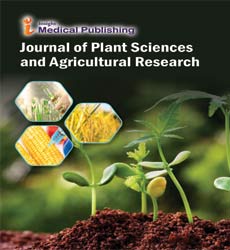Plant Virus Epidemiology: Protecting Food Safety and Crop Health
Pedro Alves*
Department of Plant Pathology, University of Trento, Trento, Italy
- *Corresponding Author:
- Pedro Alves
Department of Agriculture, University of Sydney, Sydney, Australia,
E-mail: alves_p@utsa.it
Received date: August 27, 2024, Manuscript No. IPJPSAR-24-19145; Editor assigned date: August 30, 2024, PreQC No. IPJPSAR-24-19145 (PQ); Reviewed date: September 12, 2024, QC No. IPJPSAR-24-19145; Revised date: September 19, 2024, Manuscript No. IPJPSAR-24-19145 (R); Published date: September 26, 2024, DOI: 10.36648/ipjpsar.8.3.154
Citation: Alves P (2024) Plant Virus Epidemiology: Protecting Food Safety and Crop Health. J Plant Sci Agri Res Vol.8 No.3: 154.
Description
Plant viruses are microscopic infectious agents that can cause diseases in a wide variety of plants, ranging from agricultural crops and ornamental plants to trees and shrubs. They consist of a small piece of genetic material, either DNA or RNA, enclosed in a protein coat and they lack the cellular machinery required for replication. Instead, plant viruses rely on host plant cells to replicate and spread, often causing visible symptoms such as leaf discoloration, stunting, wilting and deformities, which can lead to reduced crop yield and quality.
Plant viruses are transmitted through various mechanisms, including insect vectors, such as aphids, whiteflies and leafhoppers, which acquire the virus while feeding on infected plants and transmit it to healthy plants during subsequent feeding. Other modes of transmission include mechanical transmission through contaminated tools, equipment, or hands, as well as seed transmission, where viruses are passed from infected seeds to seedlings during germination and growth.
Once inside the host plant, viruses exploit the plant's cellular machinery to replicate and produce viral progeny, which can then spread to neighboring cells and tissues, leading to systemic infection throughout the plant. Some viruses remain localized in specific tissues or organs, causing localized symptoms, while others can move systemically through the plant's vascular system, resulting in more widespread damage.
Plant viruses exhibit remarkable genetic diversity, with thousands of different virus species identified to date, belonging to various families and genera. They can infect a wide range of plant species, including monocots and dicots, herbaceous and woody plants and annuals and perennials. Each virus has its own unique host range, symptomatology, mode of transmission and ecological niche, reflecting the intricate evolutionary relationships between viruses, their plant hosts and vector organisms.
Crop health and yield
Plant viruses have significant economic and agricultural implications, as they can cause severe yield losses and economic damage to crops worldwide. Crop plants affected by viruses include staple food crops such as rice, wheat, maize and potatoes, as well as cash crops like tobacco, cotton, tomatoes and citrus fruits. In addition to direct yield losses, plant viruses can also indirectly impact crop quality, marketability and international trade, as infected plants may exhibit reduced vigor, altered fruit characteristics, or increased susceptibility to other stresses and diseases.
Managing plant viruses requires an integrated approach that combines various control strategies, including cultural, chemical, biological and genetic methods. Cultural practices such as crop rotation, sanitation and weed control can help reduce virus inoculum and limit disease spread in the field. Chemical control measures, such as insecticides and antiviral compounds, can target vector populations or suppress virus replication within infected plants, although their efficacy may vary depending on the virus-vector-host system.
Biological control strategies involve the use of natural enemies of vector insects or antagonistic microorganisms to reduce vector populations or interfere with virus transmission. For example, parasitic wasps, predatory insects and entomopathogenic fungi can be used to control vector populations, while bio pesticides containing beneficial bacteria or viruses can disrupt vector feeding behavior or inhibit virus replication within vectors.
Genetic approaches to virus management focus on developing virus-resistant crop varieties through traditional breeding or genetic engineering techniques. Breeding for resistance involves selecting and crossing plant genotypes with natural resistance to specific viruses, while genetic engineering allows for the introduction of resistance genes from non-host species or the modification of endogenous genes to confer resistance. Transgenic crops expressing viral coat protein genes or RNA interference (RNAi) constructs targeting viral genes have been developed to provide effective and sustainable solutions for virus control in crops.
Conclusion
Plant viruses pose significant challenges to agriculture and food security, affecting a wide range of crops and causing substantial economic losses worldwide. Understanding the biology, ecology, and epidemiology of plant viruses is vital for developing effective strategies to manage and mitigate their impact on crop production. By integrating cultural, chemical, biological and genetic approaches to virus control, researchers and farmers can minimize the spread of plant viruses and protect crop yields, ensuring food security and sustainable agriculture for future generations.
Open Access Journals
- Aquaculture & Veterinary Science
- Chemistry & Chemical Sciences
- Clinical Sciences
- Engineering
- General Science
- Genetics & Molecular Biology
- Health Care & Nursing
- Immunology & Microbiology
- Materials Science
- Mathematics & Physics
- Medical Sciences
- Neurology & Psychiatry
- Oncology & Cancer Science
- Pharmaceutical Sciences
